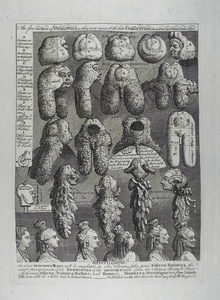| Method | Copper engraving and etching |
| Artist | William Hogarth |
| Published | Publish'd as the Act directs Octr. 15. 1761 by W: Hogarth. [J & J Boydell c.1802 impression] |
| Dimensions | Image 275 x 210 mm, Plate 305 x 220 mm, Sheet 645 x 470 mm |
| Notes |
A satire of both the recent trends in ostentatious periwigs, and the meticulous, and in Hogarth's view, absurd, detail of antiquarian studies of classical architecture. The print was inspired by the forthcoming publication of James Stuart and Nicholas Revett's 'Antiquities of Athens Measured and Delineated.' Although the publication would prove to be a watershed moment for British antiquarian studies and British Philhellenism, Hogarth's satire was proved particularly apt by the ensuing fervour for neo-classical architecture in the capital. In a manner similar to the presentation of the 'Vitruvian' or 'Palladian' five classical orders, Hogarth's plate divides fashionable periwigs into 5 distinct 'orders.' In place of the classical Tuscan, Doric, Ionic, Corinthian, and Composite, Hogarth has set up the Episcopal (or Parsonic) for the clergy, the Old Peerian (or Aldermanic) for civil servants, the Lexonic for lawyers, the Queerinthian for dandies and fops, and the Composite for those who combined a periwig with their own hair. Below the 'orders' are several representations of ladies hairstyles, as seen at the recent Coronation. The plate is even accompanied by its own scale, in the fashion of Stuart and Revett's architectural drawings, with a division made of modules, nasos (noses), and minutes. The scale itself is measured on a portrait head of James 'Athenian' Stuart himself, complete with a broken nose in the fashion of an antique marble statue. The plate is accompanied by a descriptive text outlining the various component parts of the periwig along the left border, and an inscription below which reads: 'Advertisement. In about Seventeen Years, will be compleated, in Six Volumes, folio, price Fifteen Guineas, the exact measurements of the Perriwigs of the ancients; taken from the Statues, Bustos, & Baso-Relievos, of Athens, Palmira, Balbec, and Rome, by Modesto Perriwig-meter from Lagado. N.B. None will be Sold but to Subscribers.' William Hogarth (1697 - 1764) was born in London, the son of an unsuccessful schoolmaster and writer from Westmoreland. After apprenticeship to a goldsmith, he began to produce his own engraved designs in about 1710. He later took up oil painting, starting with small portrait groups called conversation pieces. He went on to create a series of paintings satirising contemporary customs, but based on earlier Italian prints, of which the first was The Harlot's Progress (1731), and perhaps the most famous The Rake's Progress. His engravings were so plagiarised that he lobbied for the Copyright Act of 1735, commonly referred to as 'Hogarth's Act,' as a protection for writers and artists. During the 1730s Hogarth also developed into an original painter of life-sized portraits, and created the first of several history paintings in the grand manner. Paulson 208 iii/iii, BM Satires 3812 Condition: Excellent impression with full margins. Slight water stain to bottom of sheet, not affecting image. Paper watermarked 'S.Lay 1802'. |
| Framing | unmounted |
| Price | £275.00 |
| Stock ID | 38133 |

